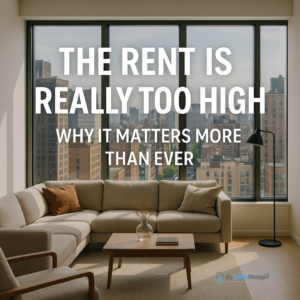In today’s housing market, the phrase “the rent is too damn high” is more than just a political slogan it’s a reality for millions of Americans. The traditional financial advice suggests that no more than 30% of your income should go toward housing. Yet, as highlighted in a 2014 AOL article, this standard has become almost impossible to maintain for many households.
With stagnant wages, rising living costs, and soaring rent prices, the dream of financial stability is slipping further away for working families, young professionals, and even middle-class earners.
The Origins and Limits of the 30% Rule
The 30% rule dates back to U.S. government housing policies in the late 20th century, designed to ensure that families could afford both housing and basic necessities. While the rule served as a benchmark for decades, the economic landscape has drastically shifted.
-
Stagnant Wages vs. Rising Rents: Over the last two decades, wages have failed to keep pace with the cost of living, while rent prices have skyrocketed in most metropolitan areas.
-
Changing Household Dynamics: Today’s renters often carry student debt, face higher transportation costs, and pay more for healthcare all of which eat into the remaining 70% of income.
For many, spending 40-50% of income on housing is now the norm, leaving little room for savings or emergencies.
The Domino Effect of Unaffordable Rent
High rent doesn’t just affect individual households it ripples through the entire economy. When families spend a disproportionate amount of income on rent:
-
Savings and Investments Take a Hit:
Without enough disposable income, renters are unable to save for a down payment on a home, invest for retirement, or build emergency funds. -
Debt Becomes the Safety Net:
Credit card debt, payday loans, and other high-interest borrowing become common stopgaps to cover basic needs, trapping families in cycles of financial stress. -
Mental Health Declines:
Financial insecurity contributes to chronic stress, anxiety, and reduced quality of life, particularly among younger renters trying to establish careers.
The Bigger Picture: Why Housing Costs Keep Climbing
Several structural issues are driving this rent crisis:
-
Housing Shortages: A lack of new, affordable housing developments forces renters to compete for limited units, driving prices higher.
-
Investor-Owned Properties: Real estate investors and corporate landlords often buy properties in bulk, raising rents to maximize profits.
-
Urban Migration: High demand for urban living, combined with limited space, creates bidding wars that inflate rental prices.
-
Inflation and Construction Costs: Rising construction and maintenance costs push developers to charge higher rents to recover expenses.
Who Is Most Affected?
Low- and middle-income households are feeling the squeeze most acutely, but even professionals earning above-average salaries are finding it hard to secure affordable housing. For younger generations, this crisis is especially pronounced:
-
Millennials and Gen Z Renters: Saddled with student loans and lower real wage growth, younger renters are often priced out of both the rental and home-buying markets.
-
Single-Income Households: Individuals living alone face significant challenges, as they cannot share rent burdens with partners or roommates.
Possible Solutions to the Rent Crisis
While the problem is complex, there are steps that can be taken to ease the burden:
-
Expand Affordable Housing Initiatives:
Governments can incentivize developers to build affordable units through tax credits, subsidies, and zoning reforms. -
Implement Rent Stabilization Policies:
Rent control and stabilization can protect tenants from sudden and drastic increases, offering more financial predictability. -
Increase Rental Assistance Programs:
Expanding programs like housing vouchers or state-funded rental relief can help bridge the gap between wages and housing costs. -
Boost Wage Growth:
Addressing wage stagnation through minimum wage increases, job training, and support for unions can give renters a fighting chance against rising costs. -
Encourage Alternative Housing Models:
Solutions like co-living spaces, tiny homes, and mixed-use developments could provide more affordable housing options in high-cost cities.
The Takeaway
The rent crisis isn’t just a personal problem it’s an economic and social challenge that affects communities, the labor market, and long-term economic growth. As the AOL article highlights, the cost of housing has reached unsustainable levels for many Americans, and without intervention, the gap between income and rent will only widen.
It’s time for policymakers, landlords, and communities to come together to rethink housing affordability. The 30% rule may no longer reflect the economic realities of modern renters, but the principle remains: people should not have to sacrifice financial security just to keep a roof over their heads.

